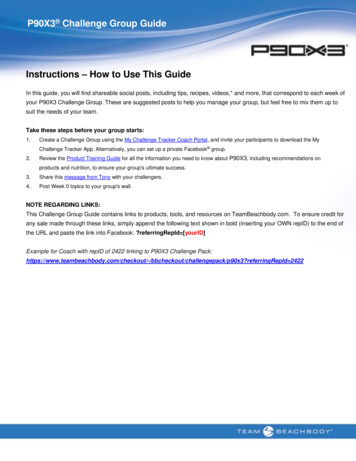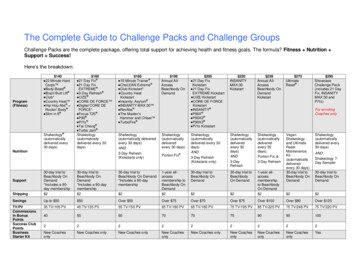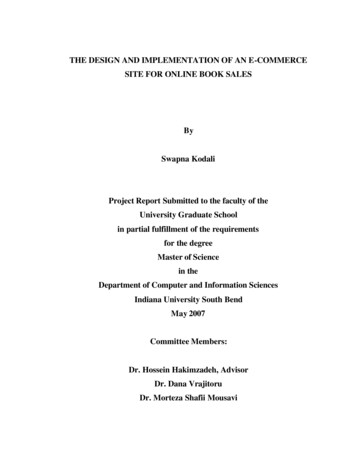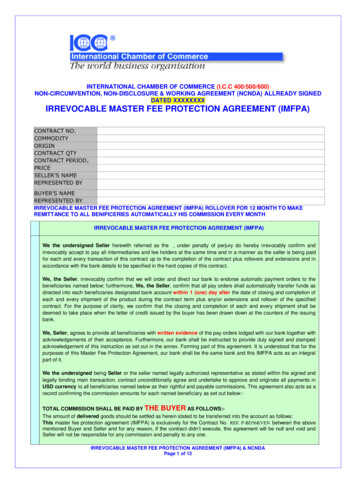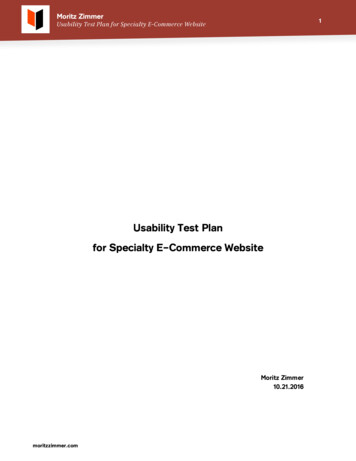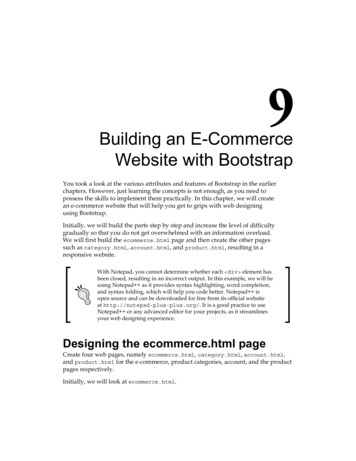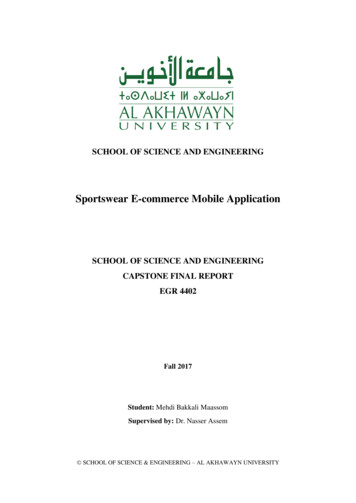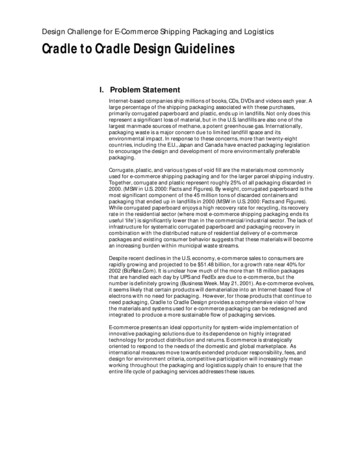
Transcription
Design Challenge for E-Commerce Shipping Packaging and LogisticsCradle to Cradle Design GuidelinesI. Problem StatementInternet-based companies ship millions of books, CDs, DVDs and videos each year. Alarge percentage of the shipping packaging associated with these purchases,primarily corrugated paperboard and plastic, ends up in landfills. Not only does thisrepresent a significant loss of material, but in the U.S. landfills are also one of thelargest manmade sources of methane, a potent greenhouse gas. Internationally,packaging waste is a major concern due to limited landfill space and itsenvironmental impact. In response to these concerns, more than twenty-eightcountries, including the E.U., Japan and Canada have enacted packaging legislationto encourage the design and development of more environmentally preferablepackaging.Corrugate, plastic, and various types of void fill are the materials most commonlyused for e-commerce shipping packaging and for the larger parcel shipping industry.Together, corrugate and plastic represent roughly 25% of all packaging discarded in2000. (MSW in U.S. 2000: Facts and Figures). By weight, corrugated paperboard is themost significant component of the 45 million tons of discarded containers andpackaging that ended up in landfills in 2000 (MSW in U.S. 2000: Facts and Figures).While corrugated paperboard enjoys a high recovery rate for recycling, its recoveryrate in the residential sector (where most e-commerce shipping packaging ends itsuseful ‘life’) is significantly lower than in the commercial/industrial sector. The lack ofinfrastructure for systematic corrugated paperboard and packaging recovery incombination with the distributed nature of residential delivery of e-commercepackages and existing consumer behavior suggests that these materials will becomean increasing burden within municipal waste streams.Despite recent declines in the U.S. economy, e-commerce sales to consumers arerapidly growing and projected to be 51.48 billion, for a growth rate near 40% for2002 (BizRate.Com). It is unclear how much of the more than 18 million packagesthat are handled each day by UPS and FedEx are due to e-commerce, but thenumber is definitely growing (Business Week. May 21, 2001). As e-commerce evolves,it seems likely that certain products will dematerialize into an Internet-based flow ofelectrons with no need for packaging. However, for those products that continue toneed packaging, Cradle to Cradle Design provides a comprehensive vision of howthe materials and systems used for e-commerce packaging can be redesigned andintegrated to produce a more sustainable flow of packaging services.E-commerce presents an ideal opportunity for system-wide implementation ofinnovative packaging solutions due to its dependence on highly integratedtechnology for product distribution and returns. E-commerce is strategicallyoriented to respond to the needs of the domestic and global marketplace. Asinternational measures move towards extended producer responsibility, fees, anddesign for environment criteria, competitive participation will increasingly meanworking throughout the packaging and logistics supply chain to ensure that theentire life cycle of packaging services addresses these issues.
Cradle to Cradle Design Challenge for E-Commerce Shipping Packaging and LogisticsII. Introduction to Cradle to Cradle DesignCradle to Cradle Design is a system of thinking based on the belief that humandesign can approach the effectiveness and elegance of natural systems by learningfrom nature and incorporating its patterns. Industry can be transformed into asustaining enterprise—one that creates economic, ecological, and social value—through thoughtful and intentional design that mirrors the safe, regenerative1productivity of nature and eliminates the concept of waste.Background: The Cradle-to-Grave LegacyTakeMakeWasteManufacturing systems of the Industrial Revolution are based on a one-way, cradleto-grave stream of materials—a model that takes, makes, and wastes. Materials aremined and refined, products are assembled, distributed, used by consumers, andthen discarded to landfills or incinerators. Each step in this stream typically createsunintended environmental and health impacts. The advent of modern industrialprocesses has had the added consequence of making many processes and materialsmore toxic. Today, the legacy of the cradle-to-grave model is routine headline news,profoundly affecting the air we breathe, the water we drink, the climate we live in,the diseases we suffer from, and global politics.In response to widespread environmental degradation, governments and industrieshave adopted a strategy known as “eco-efficiency”—minimizing waste, pollution,and natural resource depletion. Many companies have realized significant costsavings and reduced environmental impacts by embracing eco-efficiency. But longterm prosperity depends not on the efficiency of a fundamentally destructive,cradle-to-grave system. It depends on the effectiveness of processes designed to besustaining, healthy and renewable in the first place.A New Paradigm: Cradle to Cradle DesignCradle to Cradle Design offers an alternative. It rejects the assumption that humanindustry inevitably destroys the natural world, or that the demand for goods andservices is the ultimate cause of environmental ills. Instead, it embraces abundance,human ingenuity, and positive aspirations.Today, with our growing knowledge of the living earth, our designs can reflect a newspirit. Cradle to Cradle Design incorporates this new ecological awareness at everylevel of human endeavor. Its principles are built on the intelligence, abundance, andeffectiveness of natural systems—the flows of energy and nutrients that support theEarth’s biodiversity.Emulating Nature’s Material and Energy FlowsNature’s ecosystems function on some key principles that human design canemulate. First, there is no “waste” in nature; the waste from one organism providesnutrients for another. Second, all life on earth is fueled by solar energy. Third, lifethrives on diversity, constantly adapting to fill niches. Cradle to Cradle Designmodels human industry on these natural principles. It envisions a world powered bythe sun where growth is good, waste nutritious, and productive diversity enricheshuman and natural communities.The application of cradle-to-cradle principles to industry creates cyclical materialflows (cradle-to-cradle rather than cradle-to-grave) that, like the earth’s nutrientcycles, eliminate the concept of waste. Each material in a product is designed to besafe and effective, and to provide high quality resources for subsequent generations1Cradle to Cradle Design is based on principles of Industrial Ecology and Design for Environment (DfE).Similar to industrial ecology, materials and energy flows are conceived as ‘metabolisms’ and like DfE, itproposes that we design with the environment in mind, considering all phases of the product life cycle. 2003, MBDCPage 2 of 11
Cradle to Cradle Design Challenge for E-Commerce Shipping Packaging and Logisticsof products. All materials are conceived as nutrients, circulating safely andproductively in one of two “metabolisms”—the biological metabolism and thetechnical metabolism.The Biological MetabolismThe biological metabolism is the system of natural processes that support life. Theseprocesses include the degradation of organic materials and their incorporation intoorganisms—cyclical, and ultimately fueled by sunlight. Materials that contribute tothe productivity of the metabolism are biological nutrients. Ideally, products ofhuman industry designed from biodegradable, ecologically safe materials participatein the biological metabolism after use through decomposition.Example: Upholstery FabricUpholstery fabrics, which wear out with use, can be designed frombiological nutrients that can be returned to ecosystems after use.Climatex Lifecycle fabric is an example of this type of product. Thefabric is a blend of pesticide-residue-free wool and organically grownramie, dyed and processed entirely with non-toxic chemicals. All itsproduct and process inputs were defined and selected for theirhuman and ecological safety within the context of a biologicalmetabolism. Currently, the fabric trimmings (process ‘waste’) areused by garden clubs as mulch for growing fruit and vegetables,returning the textile’s biological nutrients to feed new growth.The return of Climatex Lifecycle’s nutrients to the biologicalmetabolism depends on its appropriate application and post-usehandling. The design must facilitate the clean separation of the fabricfrom materials that cannot function as biological nutrients, likesynthetic foams. Substances used to treat and clean the fabric shouldalso be compatible with the biological metabolism. Finally, the postuse cycling of the fabric’s nutrients will likely rely on a well runcomposting system. 2003, MBDCPage 3 of 11
Cradle to Cradle Design Challenge for E-Commerce Shipping Packaging and LogisticsThe Technical MetabolismIndustry can also be modeled after natural processes to create technical metabolisms,systems that productively cycle industrial materials. These materials, valuable fortheir performance qualities and typically ‘non-renewable,’ are technical nutrients,designed to circulate safely and perpetually through cradle-to-cradle product lifecycles of production, use, recovery, and re-manufacture. The processes of thetechnical metabolism are industrial rather than natural, but ideally are also fueled bythe energy of the sun in the form of renewable energy.Example: BatteriesThe well-developed system for lead-acid battery recovery provides aprovocative model for the development of technical metabolisms.Car batteries are valuable to customers for storing and providingelectricity by design, but incidentally pose risk to customers and theenvironment as a result of the hazardous materials they contain. Toreduce the risk of the release of hazardous materials, economicincentives have been built in to encourage the return of old batteriesto authorized locations with credit towards a new battery. Oldbatteries are sent to secondary lead smelters where the materialvalue of the lead, plastic and the acid is recovered for use in newbatteries. Over 95% of all lead and plastic from recovered carbatteries is recycled, making it the most recycled consumer productin the U.S.Technical metabolisms exist within the natural world and materialreleases to ecosystems are inevitable, technical nutrients ideallyshould pose little or no hazard to the biological metabolism. Lead isuniversally recognized as being so toxic that even minor releasesdamage human and ecological health. For car batteries there aresafer alternatives (e.g., lithium, zinc) that provide comparableperformance. Though these alternatives are currently moreexpensive, they do not carry the associated environmental andhealth costs of lead that we all currently subsidize. Cradle–to-cradleprinciples suggest replacing lead rather than simply optimizing thetechnical metabolism for lead acid batteries to reduce human andecological impact.Maximizing ValueJust as living organisms are more than simply the sum of their chemical composition,products have value beyond their simple nutrients or materials. For instance, abicycle has utility beyond the value of its steel, aluminum, and rubber. Productsembody the functionality and intelligence designed into them due to additiveexpenditures of labor, energy, and resources throughout the manufacturing process.The degree to which value is added along the value chain of a product is largely afunction of its materials and complexity. And while the opportunity to recover valueoccurs at various points along the value chain, economics and cradle-to-cradleprinciples advocate recovering value from a product at the highest level ofembodied value possible. As shown in the illustration, reuse and refurbishmentrecover the highest level of embodied value by maintaining the primary function ofthe product. If the product cannot be reused or remanufactured, its materials are stillvaluable. With increased energy and labor input, its materials can be recoveredeither through recycling or composting. 2003, MBDCPage 4 of 11
Cradle to Cradle Design Challenge for E-Commerce Shipping Packaging and LogisticsFor example, a bike is refurbished multiple times through replacing tires, chains, etc.– always maintaining its primary function. At the end of its useful life, the bike is fully2disassembled and materials recovered through recycling.Increasing Embodied Value(time, energy, labor, information, utility, etc.)'Virgin'ResourcesBasic ChemicalsSubstancesMaterialsProductin UseComponentsCompostingIncineration forEnergy Recovery(permanent lossof alRecyclingRefurbishmentReusePost-UseIII. Practicing Cradle to Cradle DesignThe greatest potential for realizing the positive benefits of Cradle to Cradle Design isin the early design phases of any given project, when opportunities to affect theoutcome are greatest and the resources committed to a solution are smallest. Ideally,designers should take into account all material inputs and life cycle characteristicswhen redesigning an existing product or developing a newone.Fundamental to this design process is understanding how amaterial or product flows through its various life cycle stages(raw materials extraction and production, manufacturing, use,and recovery/reutilization). This provides a context tounderstand its impacts on human health and theenvironment. Life cycle thinking informs the decision-making processes involved inintelligent design by extending the design objectives to include post-use valuerecovery, and the human and environmental safety of materials.Applying cradle-to-cradle principles, while challenging, can be energizing, allowingcompanies to envision materials as assets and create new market opportunities thatare not available within the current take-make-waste system. By redefining theboundaries of design, purchasing, manufacturing, sales and product ownership, acompany can begin to understand the business opportunities and reduced liabilitybenefits. Given the limitations of current materials and technologies, it is not alwayspossible to design a product or system that fully embodies cradle-to-cradleprinciples in the short term. However, design is a dynamic endeavor. Cradle to CradleDesign provides the long term vision for guiding the transitional steps to safer andmore effective industrial design.2The value recovery hierarchy is an accepted principle of industrial ecology and design for environment. Ithas been presented in a variety of texts including: Graedel, T.E. and Allenby, B.R. 1995. Industrial Ecology.New Jersey: Prentice Hall. p. 262. 2003, MBDCPage 5 of 11
Cradle to Cradle Design Challenge for E-Commerce Shipping Packaging and LogisticsIV. Cradle-to-Cradle Design Considerations for Packagingand LogisticsCurrently, the life cycle of most e-commerce shipping packaging is best describedby the one-way, cradle-to-grave model. The typical life cycle for an e-commercepackage made from corrugated paperboard and plastic is depicted in the diagrambelow.Simplified cradle-to-gravepackaging life cycleSeveral factors related to the system, package design, and consumer behaviorcontribute to the existing cradle-to-grave material flows.System Design ConsiderationsIn today’s cradle-to-grave life cycle, external costs to consumers associated with rawmaterial extraction, consumption of non-renewable resources, and variousenvironmental and social impacts are not reflected in the cost of packaging. Forinstance, timber harvesting is occurring on public lands, trash disposal is subsidizedby state and local taxes, and programs to remediate unintended environmentalimpacts including air and water pollution are paid for using tax dollars. Asconsumers, we typically do not think about these indirect financial costs of aproduct. Similarly, we typically do not think about the human health orenvironmental impacts of packaging that can be direct or indirect and aredistributed over its life cycle.External costs and effectsassociated with a cradle-tograve life cycle 2003, MBDCPage 6 of 11
Cradle to Cradle Design Challenge for E-Commerce Shipping Packaging and LogisticsOne of the advantages of cradle-to-cradle thinking is that the “true cost” or life cyclecosts and impacts of the materials and associated systems for packaging can beidentified and used to inform both the design and business processes. In turn, thispresents an opportunity for designers to develop better products and for business tocapitalize on the increased knowledge about their products and systems.In dollar terms, packaging materials are not expensive. The function that packagingperforms, protecting more valuable products from damage is the perceived “value”of packaging. As such, once packaging has performed its function, it is commonlyconsidered waste both by consumers and businesses, instead of a resource and/or abusiness opportunity.One of the goals of this design challenge is to change this perception by expandingthe concept of value beyond function, through a shift from cradle-to-grave to cradleto-cradle thinking. Currently, public perception of the environmental impacts ofpackaging focuses on the persistence of plastics in landfills, rather than theenvironmental and social impacts of raw material extraction, manufacturing andtransporting packaging to and from consumers, or the local to global issuesassociated with landfills, incinerators and their emissions.Some consider the relative value of packaging material to the cost of shipping abarrier to economically viable recovery schemes. Some of the questions to considerthat challenge this might include: Are there costs associated with empty delivery or mail trucks on a returnroute? Is there a business opportunity to fill them with used packaging? What is the cost savings associated with reusing a box? What are the raw material cost savings to a paper mill or plastic processorto use recovered corrugated paperboard or plastic?For the successful cradle-to-cradle flow of packaging, not only does there need to bea change in perception about the “value” of packaging once it has performed itsfunction, but additionally there needs to be development of a recovery system togather used packaging and stage it for reuse or recycling.Any effective recovery system should be a value adding process. Economic, or otherincentives can be designed to facilitate the return of used packaging from end users.Currently, there are few to no such incentives. Another characteristic of a successfulrecovery system is coordination of participants in the recovery chain and workablebusiness models for each. An example of this is the well-developed system of reverselogistics for product returns associated with e-commerce. From the Internet retailersthrough parcel delivery entities, there is a well-coordinated system of reverselogistics in place for product returns. These existing systems may provide templatesfor effective packaging recovery as part of a cradle-to-cradle design. 2003, MBDCPage 7 of 11
Cradle to Cradle Design Challenge for E-Commerce Shipping Packaging and LogisticsConsumer BehaviorConsumer behavior is an important consideration for the cradle-to-cradle design of packaging andrelated systems. A well-designed package needs a complementary system that makes it as easy aspossible for the consumer to recycle or compost the package.Some questions to consider related consumer behavior include: What economic or other incentives might encourage consumers to recycle packaging? How easy is it for consumers to disassemble and store packaging? How far will consumers travel to recycle or compost packaging?Additional benefits from Cradle to Cradle Design might include: development of a company policy with regards to materials selectionand purchasing decisionsimproved communication about environmental aspects of productinformed basis for product and process improvementsopportunity for new business strategiesimproved corporate relationsdecreased costs through reuse and recycling of packagingnew relationship with the customer that encourages repeat business (ex.discount on next purchase when packaging is returned).Packaging Design ConsiderationsThe ideal cradle-to-cradle packaging product is designed so that all of its materialsare selected to safely cycle within either a biological or technical metabolism and tobe reused or recovered at their highest possible value.Material selection is an essential part in the development of a cradle-to-cradleproduct. A designer needs to understand the human and ecological healthcharacteristics of the materials under consideration. Obviously, material science andtoxicology are not the milieu of most designers. However, increasingly there areLCA—based resources available to designers that condense human health,ecological health (eco-toxicity) and energy data by material. (See resource list onwebsite)Material SafetyMaterials can be assessed to ensure they are safe at each point of their life cycles. A material’simpact on human and ecological health can be determined by characterizing materials throughtheir entire life cycles, for impacts in four basic types of effects: Exposed organisms (carcinogenicity; endocrine disruption; irritation of skin/mucousmembranes; sensitization) The succession of generations (mutagenicity, either accidental or engineered;reproductive and developmental toxicity; persistence/biodegradation) Food chains (bioaccumulation potential) Natural systems equilibrium (global warming and ozone depletion potential)As much as possible, materials should be chosen that do not pose a risk, regardless of how theyare used. Consumers often do not use the product as the designer intended. For example, manystill burn their trash even though it is illegal. 2003, MBDCPage 8 of 11
Cradle to Cradle Design Challenge for E-Commerce Shipping Packaging and LogisticsAdditionally, a designer needs a general understanding about the origin and fate ofmaterials and their environmental impacts, within the context of the current lifecycle. This provides a basis for assessing the impact of design modifications and forunderstanding the metabolism one is designing for in a cradle-to-cradle system. Forinstance, if one is designing packaging that would ideally flow in a biologicalmetabolism (i.e. a managed composting system), the palette of materials underconsideration must be appropriate for that metabolism. Materials that arebiodegradable and safe for human and environmental health (biological nutrients)are appropriate for biological metabolisms.The diagram below depicts a corrugated paperboard package designed as abiological nutrient.Simplified cradle-to-cradlepackaging life cycle usingbiological nutrientsBecause it is biodegradable, corrugated paperboard packaging is suitable as abiological nutrient as long as the human and ecological health characteristics of allits materials, including the inks, adhesives and labels, are biologically suitable and3safe to return to natural systems. However, the raw material for virgin paper, trees,takes decades to grow. Does it make sense to use a box once and return it to soilwhen it takes 25 years for a new tree to grow to replace the raw material? As a result,there are temporal considerations associated with the suitability of a material whendesigning for the biological metabolism.In contrast, some current designs of packaging are hybrids, where materialsappropriate for technical and biological metabolisms are used together. Forinstance, a non-degradable HDPE plastic shipping label that cannot be easilyremoved from a paperboard box, poses a problem for a managed compostingsystems.If the labels can be easily removed from the box then the hybrid design isappropriate as long as all materials are safe, and systems exists for their recovery.Extra effort is required to ensure that labels are removed so that neither thebiological or technical metabolism is contaminated.3For more information on designing a package for a biological metabolism, refer to EUROPEN’s report,Understanding the CEN Standards on Packaging and the Environment: Some Questions and Answers for adescription of the EU CEN Standard on the Organic Recovery of Packaging (EN 13432:2000). 2003, MBDCPage 9 of 11
Cradle to Cradle Design Challenge for E-Commerce Shipping Packaging and LogisticsSimplified cradle-to-cradlepackaging life cycle usingtechnical nutrientsCradle-to-cradle e-commerce packaging could also be made of technical nutrientsthat cycle in a technical metabolism. An example of packaging designed as atechnical nutrient is depicted below. Plastic packaging is suitable as a technicalnutrient if: 1) all of its materials, including the plastic, inks, and adhesives, are safe forhuman and ecological health at each point of the life cycle; and 2) it can be recycled4, 5again and again, maintaining its optimum material value.Even though packaging materials may be safe toreturn to nature from a human and ecological healthpoint of view, if the system or infrastructure doesn’texist to recover value, not only is there loss ofmaterial and embodied utility, but these losses mayhave unintended impacts on the environment andhuman health (i.e. release of methane fromanaerobic decay in a landfill).The ideal cradle-to-cradle scenario allows thepackaging to be reused. Reuse recovers materials6and product utility at its highest possible value.However, after one or several cycles of use, physicalwear and tear will take its toll on almost any material.The issue becomes, at what level material value canbe recovered now that the utility of the package islost and what system is needed to achieve it. Forcorrugated paperboard or plastic, this is generallyrecycling – value is recovered in a technical system.Another possible scenario for corrugated paperboard is the recovery of its nutrientvalue through managed composting – value is recovered through the biologicalsystem.Cradle to Cradle Design Objectives and GuidelinesCradle-to-cradle principles expand the design objectives and the arena forevaluating effective e-commerce packaging. By adding recovery of healthy materialsat their highest level of value to traditional cost and performance design objectives,Cradle to Cradle Design extends the design focus to include post-use systems, andbrings to the front the environmental and human health characteristics of materials.Below is a list of traditional performance considerations and the additional cradle-tocradle guidelines by major decision area.4For more information on designing a package for a technical metabolism, refer to EUROPEN’s report,Understanding the CEN Standards on Packaging and the Environment: Some Questions and Answers for adescription of the EU CEN Standard on Material Recycling (EN 13430:2000).5Plastic, in most cases, is considered a technical nutrient. However, with the development of biopolymersand synthetic polymers designed to biodegrade, the value of selected plastics can be recovered throughbiological or technical metabolisms.6For more information on designing a package for reuse, refer to EUROPEN’s report, Understanding theCEN Standards on Packaging and the Environment: Some Questions and Answers for a description of theEU CEN Standard on Reusable Packaging (EN 13429:2000). 2003, MBDCPage 10 of 11
Cradle to Cradle Design Challenge for E-Commerce Shipping Packaging and LogisticsCradle-to-Cradle Design GuidelinesPerformance 7Does the packaging meetISTA 3C, or ASTM D4169,or ISTA 1A standards?Can the packaging beused in high speedsorting systems?Is it compatible for use inexisting air and groundtransportation logisticssystems?Are strengthrequirements met?Does the form of thepackage meet thestandard shippingrequirements for the typeof load?Does the packaging braceor block the item inposition to eliminatemovement within thecontainer?Does the packagingprotect the item’s surfacefrom abrasion, scratching,etc?Does the package provideprotection from theenvironment (i.e.moisture)?MaterialsPhysical DesignSystemEconomics and Marketing Are the materialsbiological or technicalnutrients?Are all of the materialinputs known (e.g., majorcomponents, as well asinks and adhesives)?Are the materials safe forbiological systems at allphases of the life cycle?Are the materials reusableor recyclable at a highlevel of value?How energy intensive arethe selected materials?Are materials containingrecycled content availablefor use that meetperformance and humanand environmental healthcriteria? Has the product beendesigned for easy andeffective reuse,disassembly, recycling orcomposting?Are componentsidentified by material forrecyclability?Was transportationenergy evaluated as partof package design? (e.g.,light-weighting)Has the product beendesigned to optimizematerial use (use as littlematerial as possible byvolume and weight)? What is the existing lifecycle of this type ofproduct?Are you designing for theexisting metabolism (lifecycle), for an optimizedmetabolism, or forsomething entirelydifferent?What are the post-usetake-back and recoverymechanisms of themetabolism?What is the ideal cradleto-cradle post usescenario for this product?Are componentsidentified for sorting andrecyclability?Are you designing for atechnical or biologicalmetabolism, or for both? What is the cost of acradle-to-cradle package?What are the initial andongoing costs andsavings associated withthe cradle-to-cradlepackaging and packagingsystem?Are there economicincentives for a cradle-tocradle solution?What external costs areeliminated by a cradle-tocradle solution?7Performance criteria are based on guidelines provided by the Institute of Packaging Professionals, Guide to
The application of cradle-to-cradle principles to industry creates cyclical material flows (cradle-to-cradle rather than cradle-to-grave) that, like the earth’s nutrient cycles, eliminate the concept of waste. Each material in a product is designed to be safe and effective, and to

